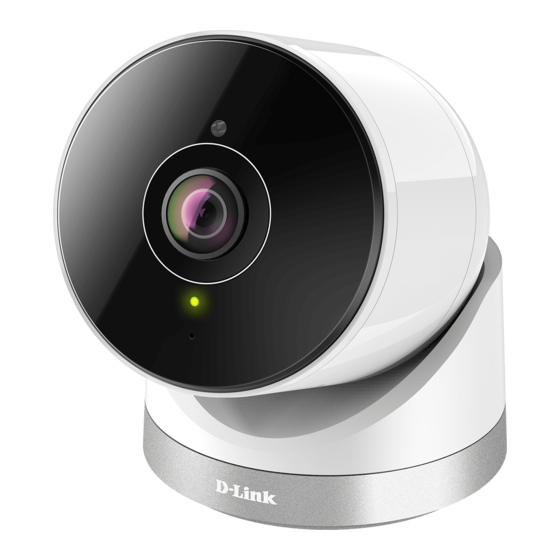
D-Link DCS-2670L Quick Install Manual
Full hd 180-degree outdoor wi-fi cam
Hide thumbs
Also See for DCS-2670L:
- Quick installation manual (129 pages) ,
- User manual (76 pages) ,
- User manual (59 pages)
Table of Contents
Advertisement
Available languages
Available languages
Quick Links
Advertisement
Table of Contents

Summary of Contents for D-Link DCS-2670L
- Page 1 DCS-2670L Full HD 180-Degree Outdoor Wi-Fi Cam Quick Install Guide...
-
Page 2: Package Contents
Package Contents DCS-2670L Full HD 180-Degree Outdoor Waterproof Cable Connector Wi-Fi Cam Power Adapter Mounting Hardware Ethernet Cable Quick Install Guide If any of the above items are missing, please contact your reseller. Minimum Requirements Mobile Device (to use mydlink Lite app) •... -
Page 3: Product Overview
Product Overview Front Light Sensor Infrared LEDs Camera Lens Power LED Microphone Camera Base Bottom Reset Button microSD Card Slot Baseplate * Supports microSD/SDXC up to 128GB... -
Page 4: Setting Up Your Camera
Setting Up Your Camera Download the free mydlink Lite app on your smartphone or tablet by scanning the QR code below, or by searching for mydlink Lite in the app store for your device. System Requirements: Refer to the mydlink Lite app page on the Apple App Store or Google Play. Launch the mydlink Lite app, then create a new account or log in to your existing account. -
Page 5: Wireless Setup
Wireless Setup To connect your camera to your network wirelessly, follow the instructions below. Once your camera is set up, select your camera and tap the Settings button. Select “Wi-Fi Setting” and “Enable Wi-Fi connection”. Select your wireless network and enter your password, then tap Apply. You can now disconnect the Ethernet cable and move the camera to your preferred location. -
Page 6: Mount The Camera
Mount the Camera Please refer to the steps below to assist you with mounting the camera. We suggest that you configure the camera before mounting. 1. Place the baseplate where you want to position the camera and use a pencil to mark the holes. You can use the large holes for a removable installation, or the small holes for a fixed one. - Page 7 Waterproofing the Camera Waterproofing Your Connectors When Using Wi-Fi After configuring your camera, follow the instructions below to prevent water from entering the camera's Ethernet and Power Cable connections. 1. Plug the power adapter into the dongle. 2. To waterproof the Ethernet socket, align the cap according to the thread and twist it clockwise to seal it.
- Page 8 FAQs 1. What can I do if my DCS-2670L is not working correctly? • Reset the camera (see next step) and run the setup steps starting on page 4 again. • To make sure your hardware is installed correctly, make sure that:...
- Page 9 Notes...
- Page 10 Notes...
- Page 11 Notes...
-
Page 12: Technical Support
May 11, 2017 RMN0102213A Copyright ©2017 All rights reserved. D-Link and the D-Link logo are registered trademarks of D-Link Corporation or its subsidiaries. Other trademarks are the property of their respective owners. Maximum wireless signal rate derived from IEEE Standard 802.11n and 802.11g specifications. Actual data throughput will vary. -
Page 13: Guide D'installation Rapide
DCS-2670L Caméra extérieur Wifi HD intégrale à 180 degrés Guide d’installation rapide... -
Page 14: Contenu De La Boîte
Périphérique réseau et service • Un routeur sans fil (802.11n/ac) avec service Internet • Un compte de messagerie (requis pour créer un compte mydlink®) Pour la garantie et les informations réglementaires, veuillez visiter : http://support.dlink.com/warranty.aspx (États-Unis) ou http://support.dlink.ca/DCS-2670L (Canada) -
Page 15: Présentation Du Produit
Présentation du produit Avant Capteur de lumière Témoins IR Objectif de caméra Voyant d’alimentation Microphone Base de la caméra Bouton de Port de carte réinitialisation microSD* Plaque de base * Prend en charge les cartes microSD/SDXC jusqu’à 128 Go... -
Page 16: Configuration De Votre Caméra
Configuration de votre caméra Téléchargez l'application gratuite mydlink Lite sur votre smartphone ou votre tablette en scannant le code QR ci-dessous, ou en recherchant mydlink Lite dans l'app store de votre appareil. Configuration système requise : Reportez-vous à la page de l'application mydlink Lite sur l'App Store d'Apple ou Google Play. -
Page 17: Configuration Sans Fil
Configuration sans fil Pour connecter votre caméra à votre réseau sans fil, suivez les instructions ci-dessous. Une fois que votre caméra est configurée, sélectionnez votre caméra et appuyez sur le bouton paramètres. Sélectionnez "Wi-Fi Setting" (réglage Wi-Fi) et "Enable Wi-Fi connection" (Activer la connexion Wi-Fi). -
Page 18: Montage De La Caméra
Montage de la caméra Reportez-vous aux étapes ci-dessous pour vous aider à monter la caméra. Nous suggérons de configurer la caméra avant de la monter. 1. Placez la plaque de base où vous souhaitez positionner la caméra et utilisez un crayon pour marquer les trous. - Page 19 Imperméabilisation de la caméra Imperméabiliser vos connecteurs lorsque vous utilisez Wi-Fi Après avoir configuré votre caméra, suivez les instructions ci-dessous pour empêcher l'eau d'entrer dans le câble Ethernet et le câble d'alimentation de la caméra. 1. Branchez l'adaptateur secteur dans le dongle. 2.
-
Page 20: Questions Fréquentes
Questions fréquentes 1. Que puis-je faire si mon DCS-2670L ne fonctionne pas correctement? • Réinitialisez la caméra (voir l'étape suivante) et réexécutez les étapes de configuration à partir de la page 4. • Pour vous assurer que le matériel est bien installé, vérifiez les points suivants :... - Page 21 Remarques...
- Page 22 Remarques...
- Page 23 Remarques...
-
Page 24: Assistance Technique
11 mai 2017 RMN0102213A Copyright ©2017. Tous droits réservés. D-Link et le logo D-Link sont des marques déposées de D-Link Corporation ou de ses filiales. Les autres marques commerciales appartiennent à leurs propriétaires respectifs. Débit maximum du signal sans fil provenant des caractéristiques 802.11n et 802.11g de la norme IEEE.








